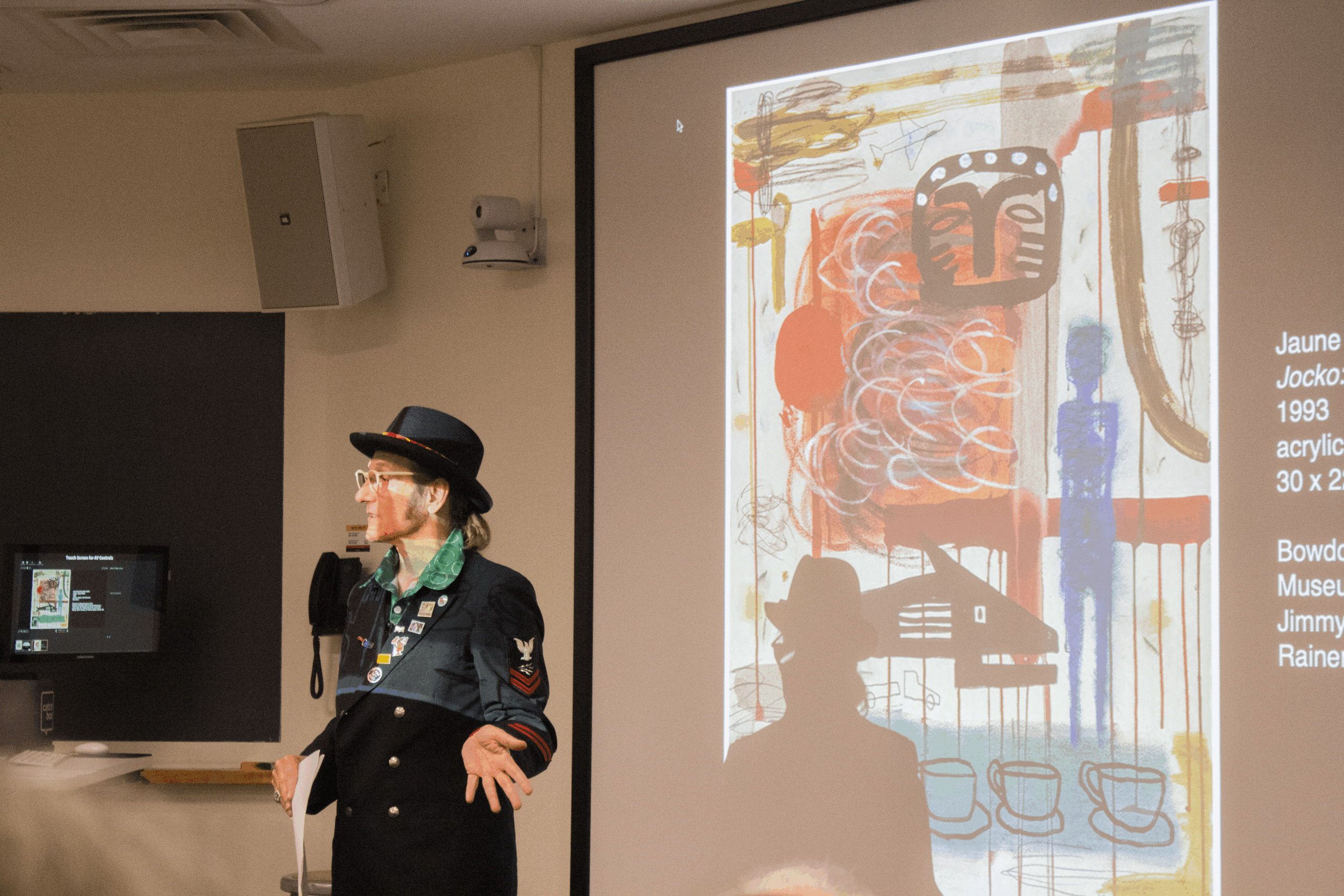Neal Ambrose-Smith visits to explore Native American iconography of mother Jaune Quick-to-See Smith’s art
October 17, 2025
 Addison Moore
Addison MooreOn the second floor of the Bowdoin College Museum of Art (BCMA), tucked in the corner of the “Currents” gallery, hangs an eye-catching drawing of color, line, shape and symbol.
Jaune Quick-to-See Smith’s 1993 mixed media work “Jocko: Gray Whale” captures much of what the artist became best known for over the course of her career. An educator and activist who curated more than 30 exhibitions during her lifetime, Smith is well known for combining traditional Native American iconography with non-Native motifs.
“If you want to understand contemporary art making of the recent past, you want to include Jaune Quick-to-See Smith in your collection,” BCMA Co-Director Frank Goodyear said.
Smith’s inclusion in the collection also serves the museum’s ongoing effort to represent historically marginalized artists and traditions.
“We’re always looking back to the collection and asking ourselves, ‘What is well represented?’ And then, ‘Where are the gaps?’” Goodyear said.
“Jocko: Gray Whale,” named for the river that flows through the Flathead Indian Reservation in Western Montana, is the BCMA’s first piece by Smith, and its acquisition was made possible by three Bowdoin alumni in memory of Yvonne Swann Simon ’82. Jimmy Ellis ’82, Martha Henry ’82 and Leslie Rainer ’82 worked with the BCMA to select a work that would both memorialize their late friend and align with the BCMA’s interests.
“[Ellis] shared that they would be particularly interested in artists who had a drawing practice, particularly interested in women artists, and that [Simon] really liked bright colors and was very fun and playful,” BCMA Curator Casey Braun said.
Once the group found Smith’s “Jocko: Gray Whale,” they were quickly decided.
“I think there’s a really nice parallel that we’re honoring two extraordinary women,” Braun said.
Smith passed away earlier this year at the age of 85 amid the museum’s efforts to acquire her work, making the addition to the collection all the more meaningful.
Smith’s son, Neal Ambrose-Smith, visited campus on October 9 to meet with students for lunch and give a brief evening presentation on his and his mother’s work. An artist himself, Ambrose-Smith worked closely with his mother on individual projects and larger exhibitions. His artistic style similarly engages with both pop cultural and Indigenous elements, pairing humor with astute societal commentary.
In addition to discussing “Jocko: Gray Whale,” he shared some of his mother’s poetry and letters. With Simon’s family and friends in attendance, the event was a space for artistic appreciation and preservation of memory.
Ambrose-Smith shared his admiration for his mother, giving material life to the woman whose art now hangs in the BCMA.
“I’m just captivated by her work. Being able to study it and be around it just blows me away all the time,” Ambrose-Smith said. “Still, almost daily, I am awestruck by her ability.”
The discussion accomplished what Braun hopes will be a step toward demystifying artistic and professional figures, thus enhancing the visibility of Indigenous communities and their place in modern society.
“Native American communities are not isolated: They’re not stuck in time. They are encountering popular culture in the same way that anyone is,” Braun said.
This contemporary focus appears often in Smith’s work and in “Jocko: Gray Whale,” which places the Indigenous motifs of a mask and handprint alongside emblems of the modern world such as an airplane and pickup truck.
Goodyear hopes that students who engage with Smith’s work will expand their definition of American art to include people and traditions that have been excluded.
“There are many rich artistic traditions in this country, and they come from communities, places all throughout the United States, not simply New York City or Los Angeles,” says Goodyear.
Similarly, Ambrose-Smith encouraged engagement with art, regardless of one’s technical knowledge, continuing Smith’s legacy of creating art that can be appreciated by all—no matter their cultural or educational background.
“Looking at anybody’s work, and [Smith] would say this, anybody, art-trained or not, if you see artwork that you like, that is what you want. That has value. You don’t have to have an art background to appreciate art. Everybody appreciates art. There’s art for everybody,” Ambrose-Smith said.

Comments
Before submitting a comment, please review our comment policy. Some key points from the policy: